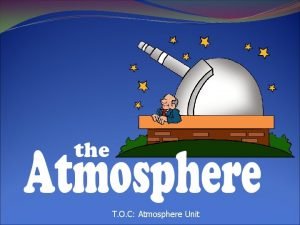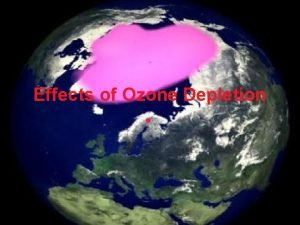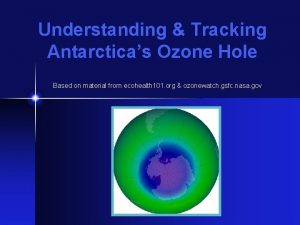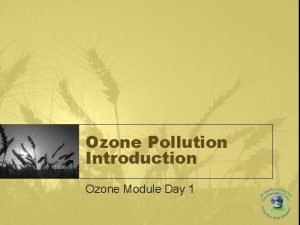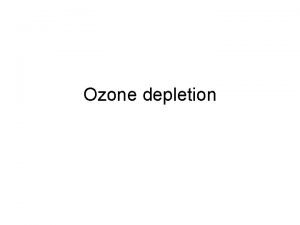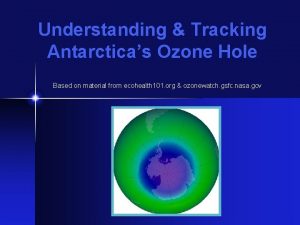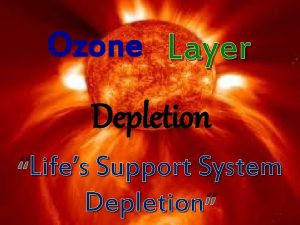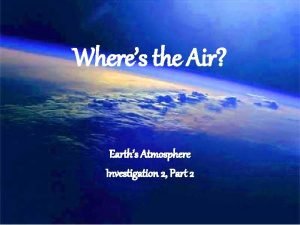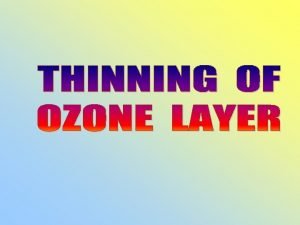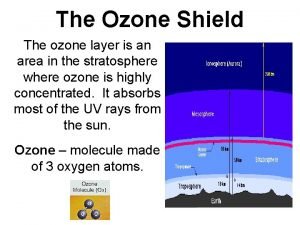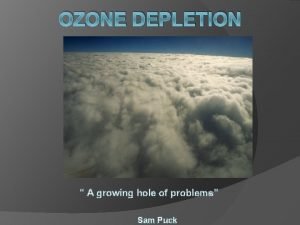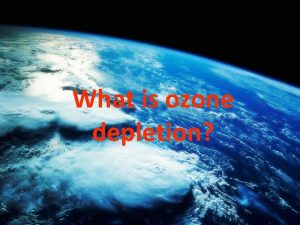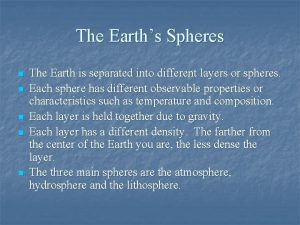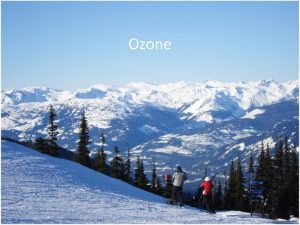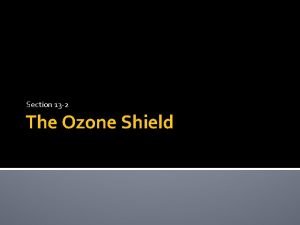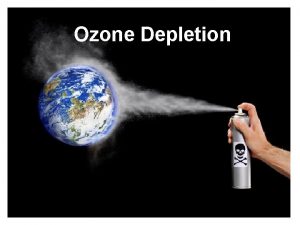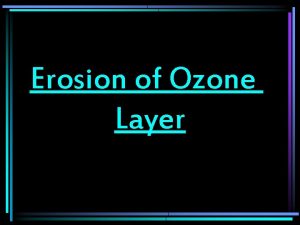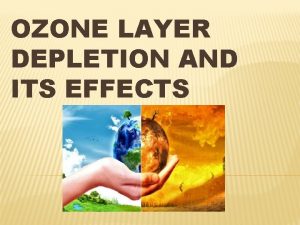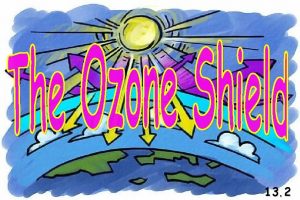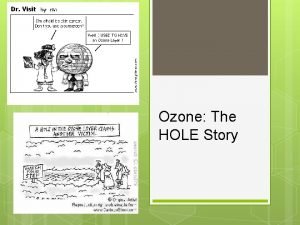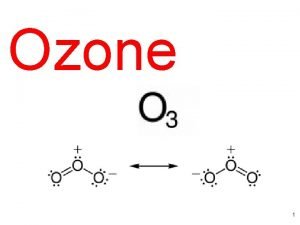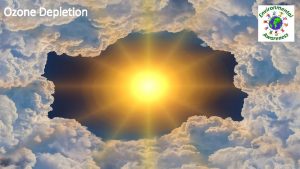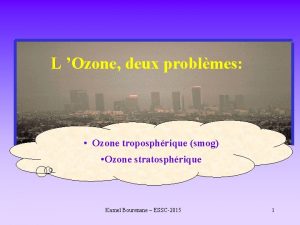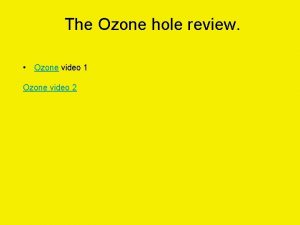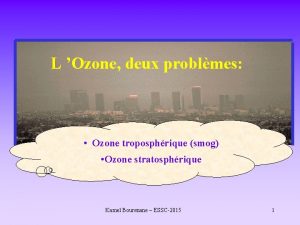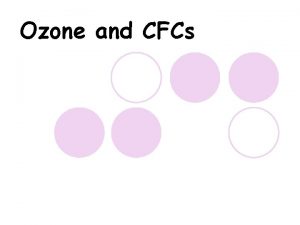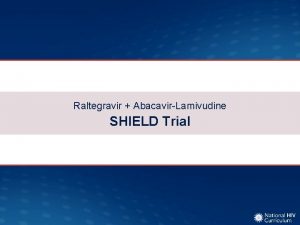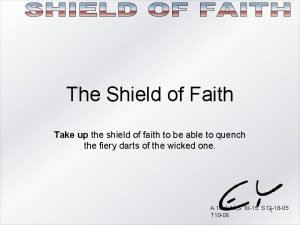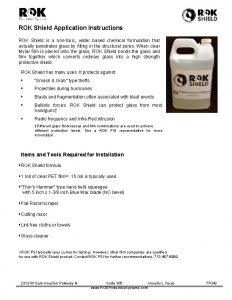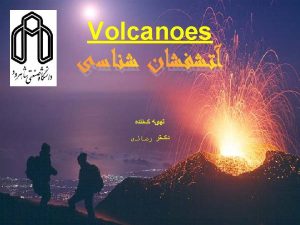The ozone layer or ozone shield is a

























- Slides: 25


Ø The ozone layer or ozone shield is a region of Earth's stratosphere that absorbs most of the Sun's UV radiation. Ø It contains high concentration of ozone (O 3). Ø It is a pale blue gas at room temperature. Ø The ozone layer protects life on earth from strong uv radiation.


OZONOSPHERE �The lower region of stratosphere containing relatively higher concentration of ozone is called Ozonosphere. �The Ozonosphere is found 15 -35 km above the surface of the earth.

UV UV radiation is divided into three categories ü UV-A (400– 315 nm) ü UV-B (315– 280 nm) ü UV-C (280– 100 nm) � Ozone is transparent to most UV-A, so most of this longer-wavelength UV radiation reaches the surface. � UV-B radiation can be harmful to the skin and is the main cause of sunburn; can also cause skin cancer. Some UV-B is important for the skin's production of vitamin D. � UV-C, which is very harmful to all living things, is entirely screened out by a combination of dioxygen and ozone.


Chemical Composition � An ozone molecule consists of three oxygen atoms (O 3) � The stable form of oxygen consists of only two. � When certain chemical processes make an extra oxygen atom available, the highly reactive atom binds readily with an oxygen molecule.

q. The ozone layer was discovered in 1913 by the French physicists Charles Fabry and Henri Buisson. q. Its properties were explored in detail by the British meteorologist G. M. B. Dobson q. The "Dobson unit", a convenient measure of the amount of ozone overhead, is named in his honor.

Production of Stratospheric Ozone v UV light from the sun reacts with oxygen molecules to form the stratospheric ozone layer. v When the energetic light strikes oxygen molecules, it breaks them into two separate oxygen atoms and each of the highly reactive atoms bind with another oxygen molecule, resulting in the formation of two ozone molecules. � Chemically, this can be described as: O 2 + ℎνuv → 2 O O + O 2 ↔ O 3

Production of Tropospheric Ozone q Because it is such a corrosive gas, ozone in the lower atmosphere is known as bad ozone. q One of them occurs inside automobile engines, where oxygen and nitrogen gas combine to form nitric oxide. q This gas reacts with oxygen to form nitrogen dioxide. q On sunny, hot days, nitrogen dioxide breaks down again to release an oxygen atom, which in turn binds with an oxygen atom to form ozone.

� The ozone layer acts as a shield to absorb the UV rays, and keep them from doing damage at the Earth's surface. � Without the layer of ozone in the atmosphere, it would be very difficult for anything to survive on the surface. � Plants cannot live and grow in heavy uv radiation, nor can the plankton. � Ozone is useful as a deodorizing and bleaching agent � As well as for killing germs and purifying water.

� There is also a kind of ozone developed just above the ground as a result of sun rays coming into contact with pollution in the atmosphere, which is hazardous to human health. � In some individuals, it can lead to complications in breathing.









� A severe depletion of ozone in a region of the ozone layer, particularly over Antarctica and over the Arctic. The depletion is caused by the destruction of ozone by CFCs and by other compounds, such as carbon tetrachloride (CCl 4) and carbon tetrafluoride (CF 4).

� The distribution of total ozone over the Earth varies with location on timescales that range from daily to seasonal. The variations are caused by large-scale movements of stratospheric air and the chemical production and destruction of ozone. � Total ozone is generally lowest at the equator and highest in polar regions.

� Total ozone at any location on the globe is defined as the sum of all the ozone in the atmosphere directly above that location. � Most ozone resides in the stratospheric ozone layer and a small percentage (about 10%) is distributed throughout the troposphere. Total ozone values are often reported in Dobson units denoted as “DU. ” Typical values vary between 200 and 500 DU over the globe. The ozone molecules required for total ozone to be 500 DU around the globe, for example, could also form a layer of pure ozone gas at Earth’s surface having a thickness of only 5 millimeters (0. 2 inches).

� Total ozone varies strongly with latitude over the globe, with the largest values occurring at middle and high latitudes during all seasons. This is the result of ozone production rates from solar ultraviolet radiation that are highest on average in the tropics, and the large-scale air circulation in the stratosphere that slowly transports tropical ozone toward the poles. Ozone accumulates at middle and high latitudes, increasing the thickness (or vertical extent) of the ozone layer and, at the same time, total ozone. � In contrast, the values of total ozone are the lowest in the tropics in all seasons (except in the ozone hole) because thickness of the ozone layer is smallest there.

 Atmosphere unit
Atmosphere unit Ozone layer depletion effects on humans
Ozone layer depletion effects on humans Causes of the ozone depletion
Causes of the ozone depletion Protective ozone layer
Protective ozone layer Ozone layer
Ozone layer Ozone layer depletion introduction
Ozone layer depletion introduction Ozone layer levels
Ozone layer levels Ozone layer depletion
Ozone layer depletion Wheres the ozone layer
Wheres the ozone layer Herbicides definition ap human geography
Herbicides definition ap human geography Ozone layer made up of
Ozone layer made up of Ozone depletion negative effects
Ozone depletion negative effects Differentiate between primary and secondary pollutants
Differentiate between primary and secondary pollutants Ozone layer simple definition
Ozone layer simple definition Protection of ozone layer
Protection of ozone layer Protective ozone layer
Protective ozone layer Layer-by-layer assembly
Layer-by-layer assembly Path of food from mouth to anus
Path of food from mouth to anus Secure socket layer and transport layer security
Secure socket layer and transport layer security Layer 2 vs layer 3 bitstream
Layer 2 vs layer 3 bitstream Secure socket layer and transport layer security
Secure socket layer and transport layer security Secure socket layer and transport layer security
Secure socket layer and transport layer security Presentation layer functions
Presentation layer functions Layer 2 e layer 3
Layer 2 e layer 3 Pigmented layer and neural layer
Pigmented layer and neural layer Secure socket layer and transport layer security
Secure socket layer and transport layer security
